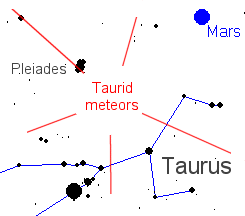
Every year in late October and early November, ~ Earth passes through a river of space dust associated with Comet Encke. Tiny grains hit our atmosphere at 65,000 mph. At that speed, even a tiny smidgen of dust makes a vivid streak of light–a meteor–when it disintegrates. Because these meteors shoot out of the constellation Taurus, they’re called Taurids.
“We came up with this model of a swarm within the Taurid stream to explain enhanced numbers of bright Taurid meteors being observed in particular years.” They listed “swarm years” in a 1993 paper in the Quarterly Journal of the Royal Astronomical Society and predicted an encounter in 2005. It seems to be happening.
You might see a fireball flitting across the sky any time Taurus is above the horizon. At this time of year, the Bull rises in the east at sunset. The odds of seeing a bright meteor improve as the constellation climbs higher. By midnight, Taurus is nearly overhead, so that is a particularly good time.
According to the International Meteor Organization, the Taurid shower peaks between Nov. 5th and Nov. 12th ~. “Earth takes a week or two to traverse the swarm,”~. “This comparatively long duration means you don’t get spectacular outbursts like a Leonid meteor storm.” It’s more of a slow drizzle–“maybe one every few hours”~.
A drizzle of fireballs, however, is nothing to sneeze at. So keep an eye on the sky this month for Taurids.
Does it feel safe to blast through a debris cloud while screaming around the Sun at 18.55 miles per second?
Maybe we should slow down a little bit.

“… screaming around the Sun …?” Who’s screaming? I’M not screaming… Do YOU hear screaming?